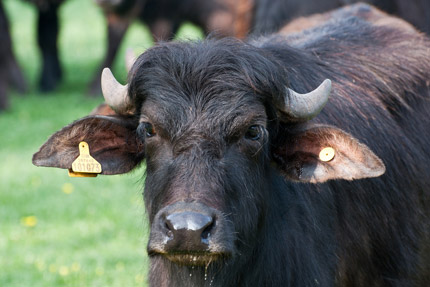Some time ago Chris Philo (1998) wrote of animals in 19th century London and how, over time, large animals such as pigs, sheep and cows have become largely absent from the city. Undoubtedly in many cities throughout the world animals do remain a common sight: one has only to think of some of the privileges cows enjoy in India. Nevertheless, in a UK context, large animals are rarely seen in the city.[1] Instead, animals are kept to the peripheries of cities; no longer are animals walked or ‘driven’ (herded) into city centres on their way to market or slaughter. The reason such activities are avoided are clear, for example, the chaos and transport disruptions caused if large animals were to walk down congested city thoroughfares. However, I want to share one example I recently came across where animals may be present in the city.
My considerations begin at a farmers’ markets and a stall selling meat – buffalo to be precise. Here, behind the stall was a picture of Daisy, a fine looking cow. I had approached the stall thinking about buying some meat, but was drawn to the picture. I am no expert, but to me the picture of Daisy hanging behind the stall, made me think that she looked like a happy healthy buffalo. I asked the farmer standing behind the stall about Daisy, as her name was beside the picture, and he told me Daisy was the animal that had been slaughtered in preparation for that particular market. As I witnessed, when asked by customers the farmer would point Daisy out as being the very animal they were about to purchase. I found this interesting and questioned him further. The picture, he informed me, changed from market to market, as each animal was slaughtered, but with a herd of over 250 animals it is hard to keep track of all the names, so generally animals only receive a name once chosen for slaughter. (There are exceptions to this, as his children often have favourites who receive early names.) This undoubtedly was a marketing and publicity tool highlighting the traceability of the animal; however the picture of Daisy may inspire something else.
In many ways, buying meat is visual and tactile, in the sense that attention is usually focused on how the meat looks or its weight. The realization that this was once a living thing is often sanitised, to the extent that it remains relatively secondary to consideration. However, in this instance, the visual appreciation of the meat is reconnected to its original being; the farmer encourages a direct contact between beast and buyer. ‘Daisy goes to market’ is a reconstruction or a re-presentation of the meat as a living thing. Channelling appreciations and understandings in such a way, the origins of the product are there for all to see, and are celebrated in a very direct manner. As the picture behind the stall does not present a generic image of an animal, but the very animal lying on the stall in front of the consumer, there is a closure of distance between animal and customer. The middle bit of the journey is still missing though; how Daisy was slaughtered, cut-up and vacuum-packed is not there. Despite this when looking at a picture of Daisy standing in a field, an awareness of the journey is encouraged. As I experienced, in the moment of looking at the meat and looking up at Daisy I made a connection about what I was about to consume and what was once a living animal.
Resonances of farm life are often far removed at farmers’ markets – and indeed at other outlets selling meat. By wrapping meat, a type of sterilization occurs; there is plastic, between meat and consumer.[2] As de Certeau (1998: 208) contends, ‘to do one’s shopping, one really has to love reading and know how to decipher labels’. However, what is at issue here is what the consumer is not aware of, or possibly has lost, their direct link to the animal, and as Cook and Willis (2004, 2006; 1991) have suggested, what about the toil of the sorting shed or the sweat of the fruit packer? Such activities are rarely evident in how we buy food. There are many interruptions along commodity chains where activities and ‘nasty’ processes or by-products are ignored or hidden. In the case of Daisy and seeing her picture I am puzzled as to whether everything is still interrupted or in some way a connection has been made. While I always knew beef came from cows, I did not know from what cow. Daisy is in the city and her presence, for me at least, awakens some sort of connection, or re-connection, to what I am consuming.
References
Cook, I (2004) Follow the Thing: Papaya, Antipode 36(4): 642-664.
Cook, I (2006) Geographies of food: following, Progress in Human Geography 30: 655-666.
De Certeau, M, Giard, L, & Mayol, P (1998) The Practice of Everyday Life Vol.2: Living and Cooking. Minneapolis: University of Minneapolis Press.
Philo, C (1998) Animals, Geography and the City: Notes on Inclusions and Exclusions, in J. Wolch & J. Emel (eds) Animal Geographies pp. 51-71 London: Verso.
Willis, S (1991) A Primer for Daily Life. London: Routledge.
[1] Notable exceptions are festivals, for example the running of the bulls in Pamplona, Spain. In addition, animals in the city can occasionally be the centre of protest, for instance when run to the doors of government offices (see news.bbc.co.uk/1/hi/uk_politics/488503.stm
or news.bbc.co.uk/1/hi/programmes/politics_show/6271025.stm).
[2] Animal products ‘unpacked’ can be seen in many butcher shops or delicatessen counters in supermarkets, but even here there is a degree of packing, as the product is generally displayed behind a glass cabinet and the food is seldom touched or examined by the consumer before purchase.
Acknowledgements
Image by Tim Parkinson, used under a Creative Commons license.
